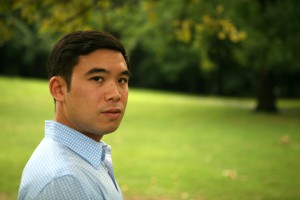Henry Wong Doe, pianist, entitled his March 26th Weill Hall Recital “A Picture of New Zealand” and dedicated the first half of his program to the music of his countryman Gareth Farr, and the second half to his performance of Mussorgsky’s “Pictures at an Exhibition”.
Farr, born in 1968, as the program notes stated, is “recognized as one of New Zealand’s leading composers.” He studied composition and percussion performance at the University of Auckland and at Victoria University, Wellington. He moved to the United States to pursue studies at the Eastman School of Music with Samuel Adler and Christopher Rouse. A recipient of many commissions and performances, Farr’s music is particularly influenced by his extensive study of percussion–both Western and Non-Western. Rhythmic elements of his can be linked to the exciting rhythms of Barotongen log drum ensembles, Balinese gamelan and other percussion music of the Pacific Rim. In 2006, Gareth Farr was made an officer of the New Zealand Order of Merit for services to music and entertainment, and most recently in 2010, he was the recipient of the prestigious New Zealand Arts Laureate Award.
The evening began with two of Farr’s works for solo piano: 1) “Tentang Cara Gamelan”, dating from 1994, when Farr was still a student at Eastman. The piece is redolent of both Farr’s early interest in Gamelan music, as well as his fascination with French Impressionism such as Debussy, et al. In an early note, Farr cites an imaginary dinner conversation between Debussy and the composer/ethnomusicologist Colin McPhee. While they initially discuss the role of Gamelan in each of their musical styles, professional jealousy disintegrates the conversation into a barrage of tongue-in-cheek insults. Henry Wong Doe’s lively performance, and especially the way he realized the music’s peppery virtuosity via his gestural way of playing the piano (which I found engaging visually) were beneficial to both protagonists. 2) “The Horizon from Owhiro Bay”, a short work commissioned by the James Wallace Trust for pianist Stephen Depledge as part of his program of Landscape Preludes by New Zealand composers, together with eleven other short works. Depledge gave the premiere in February 2008 in New Zealand, and Mr. Wong Doe gave the piece its North American premiere in his debut recital at Weill Recital Hall. Gareth Farr vividly conjures the Prelude’s descriptive aspects (Moody green depth; Inky blue sky; Endless unbroken horizon; Fishing Boats sitting on the horizon all lit up; occasional gusts of wind; wild eddies on the surface of the water; the odd rogue wave (hurling itself onto the rocks and up into the air in a spectacular explosion of sea spray, et al). It is a fine mood piece and I am looking forward to hearing Henry Wong Doe’s forthcoming recording of Farr’s Piano Music (Horizon MMT 2070).
The two piano solos were followed by a pair of chamber music compositions, one for flute and piano: “Nga Whetue e Whitu” (“The Seven Stars”), commissioned for Bridget Douglas (principal flautist in the New Zealand Symphony) and his regular pianist, Rachel Thomson. Alternating Messiaen-like harmonies with Farr’s moto perpetuo energy and sharp, articulated notes, he propels the music at a feverish pace. Both of its two movements are united by Farr’s expansion of long lyrical passages and unique amalgamation of rhythm and sonority. It was expertly played, with a cool “white” tone by Jesse Schiffman, flautist, and Henry Wong Doe.
But it was “The Shadow of the Hawk”, a 1997 work, originally commissioned by cellist James Tennant and pianist Katherine Austion that made the strongest impression on this listener. Farr writes about this composition: “The shadow of the hawk rises and falls as the landscape gently undulates beneath it. One moment it is indistinct and unfocused, the next it snaps into clear definition as the ground rises. A rocky outcrop thrusts up towards the sky.” Farr’s use of the cello confounds the usual conventionality—“the unique combination of cello pizzicato and piano bass notes in the opening gives the work an almost ‘jazzy’ groove.” How fascinating to hear the usually expansively melodic cello used as a percussion instrument. This was a brilliant performance by Mr. Wong Doe and Jisoo Ok, a Korean-born former pupil of Bonnie Hampton and Fred Sherry (Bachelor’s and Master’s at Juilliard).
Mr. Wong Doe’s version of Mussorgsky’s “Pictures”, though a shade raw and unpolished, had great vitality and engaging thrust and characterization. He was at his best in some of the more aggressive Promenades (e.g. the opening one, and the final one just before Limoges), Gnomus, Baba Yaga, which had the appropriate sinister ferocity, and The Old Castle, which came forth with a long, flowing line (this vignette, believe it or not, has moments that are surprisingly Schubertian!). Other scenes had their drawbacks: Bidlo, for all its appropriate weight and ponderousness, sounded unrelievedly stolid and brutal. Tuilleries and The Unhatched Chicks lacked delicacy, humor and playful animation. The portrait of Samuel Goldenberg was suitably pompous, though his counterpart Schmuyle was stiff and unmemorable (but credit Mr. Wong Doe for superbly closing that piece with a correct C, D flat, B flat, B flat!). Best of all was the wonderfully inclusive, bustling Limoges Market Place. Alas, the Great Gate of Kiev, which ought to have been the suite’s proper capstone, was more than a bit anticlimactic and sectionalized. (The dangerous first note, coming right after the ferocious lead-in can be brilliantly effective at times but can dangerously fall flat as a pancake—as it did on this particular occasion). But enough faultfinding: Henry Wong Doe’s guided tour (he opted for Mussorgsky’s original unbowdlerized text), though not in the Richter class, was an extremely worthy effort.
I am most grateful to the pianist for lavishing his attention on the music of Gareth Farr. Incidentally, another of Farr’s pieces, entitled “Love Song” was played as an encore after the “Pictures”. (It sounded much more popsy and Flower Child-like, and not at all like the other Farr pieces on the concert’s first half).

